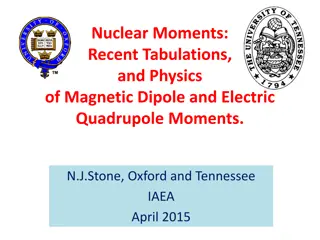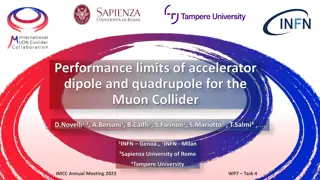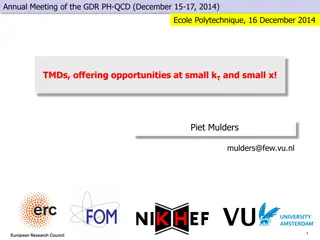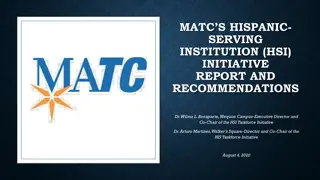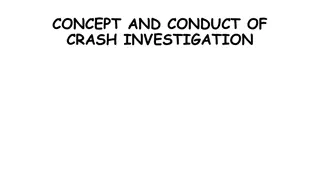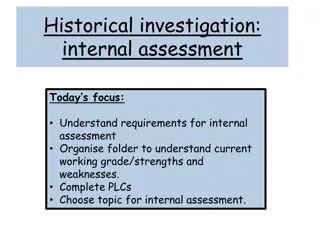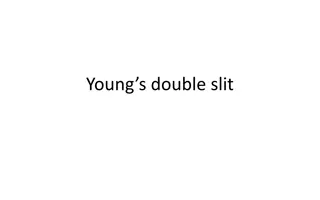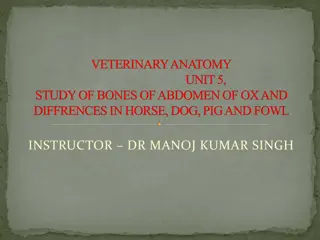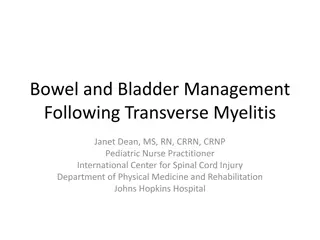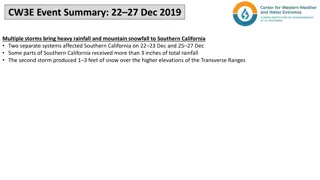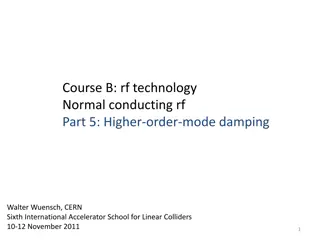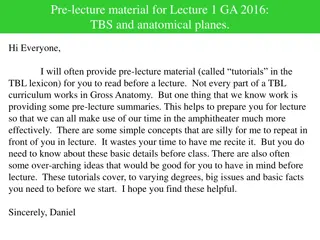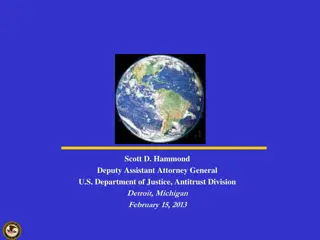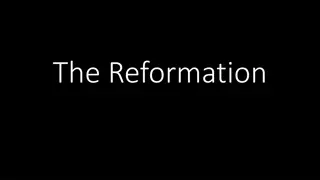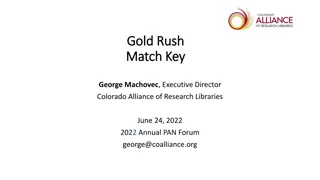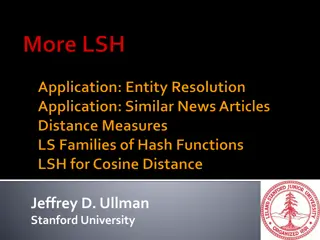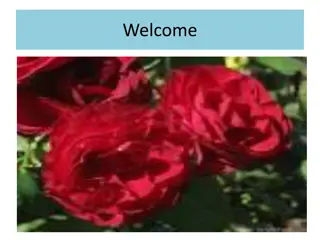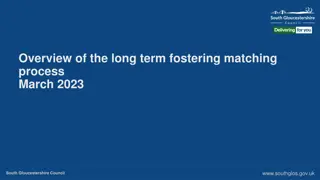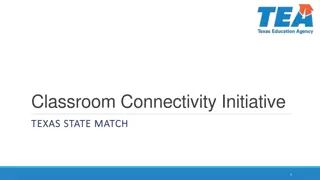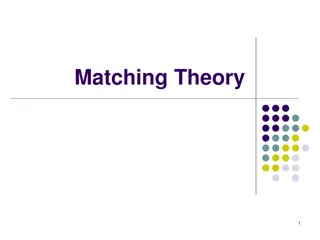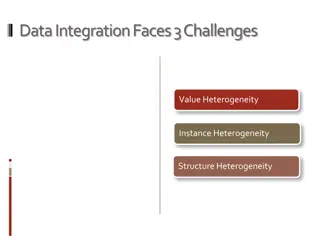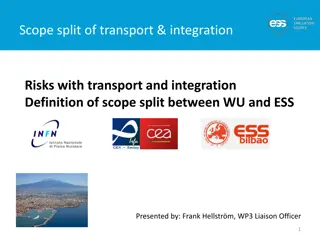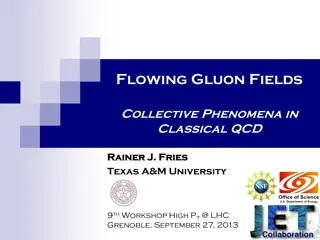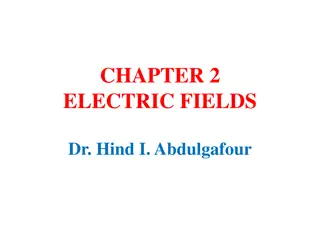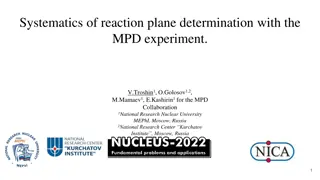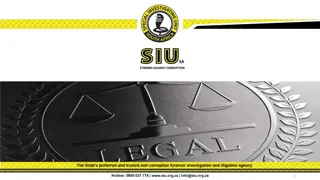Investigation of Overlapped Quadrupole Fringe Fields for HSI-RFQ Transverse Matching
General introduction to the study on quadrupole fringe fields, focusing on investigating the effects of overlapped fringe fields on HSI-RFQ transverse matching by introducing a new QQ focusing system and measuring transmission efficiency with comparisons between simulations and experiments. The study also examines the reduction in effective values due to overlapping fringe fields and utilizes standard transfer matrix methods.
Download Presentation

Please find below an Image/Link to download the presentation.
The content on the website is provided AS IS for your information and personal use only. It may not be sold, licensed, or shared on other websites without obtaining consent from the author. Download presentation by click this link. If you encounter any issues during the download, it is possible that the publisher has removed the file from their server.
E N D
Presentation Transcript
Effects of overlapped quadrupole fringe fields for HSI- RFQ transverse matching C. Xiao UNILAC post stripper upgrade department, GSI
Outline general introduction transfer matrix method introduction of new QQ focusing system measured one-dimensional field-map including fringe field Mathcad program comparing of results of hard edge and fringe field models conclusion C. Xiao, PSU/GSI, QQ investigation
HSI-LEBT and quadrupole quartet (QQ) C. Xiao, PSU/GSI, QQ investigation 9/14/2024 3
General introduction 5: vary the proposed setting in order to maximize transmission efficiency 1: replacement of the QQ by a new one 2: commissioned with low and high current Argon beam 6: re-simulate all measurements and compare simulations and experiment 3: measuring Twiss parameters in front of the new QQ 7: using the transfer matrix (hard-edge mode) method showed best setting (experiment) not as proposed, but 1.075 times the proposed values disagreement: 4: matching the envelope to the HSI- RFQ, set proposed setting, and measure HSI-RFQ transmission efficiency C. Xiao, PSU/GSI, QQ investigation 9/14/2024 4
Idea of quadrupole fringe field overlap No to be investigated No will the overlapped fringe field of quadrupoles reduce the effective values: ? ?? C. Xiao, PSU/GSI, QQ investigation 9/14/2024 5
Standard transfer matrix method ??? ?? ? ??? ?? ? ? ?= ? ? ? ??? ?? ???? ?? ??? ?? ? ??? ?? ? ? ? ? ? ? ??? ?? = ???? ?? ? ?? ???????? ????????? ? = C. Xiao, PSU/GSI, QQ investigation 9/14/2024 6
Algorithm of precise fitted function small step (more measures) means precise fitting ? ? = ??? ? +2??? ?2+ 3??? ?3 position ?1 ?2 ?? ?1 ?2 ?? ? = ?1 1???????? ? = ?2 2???????? ? = magnetic gradient a fitting function can be described as ??? ? = ?????? ?,?,?,? a cubic spline non-linear function can be written ? = ??????? ?,? C. Xiao, PSU/GSI, QQ investigation 9/14/2024 7
Measured field maps of the QQ quadrupoles courtesy F. Kloos et al. effective length of quadrupole is calculated as ??????? ? ?? ?????? ??? ? = 0 ? = maximum gradient ??? ? = 0 numerical integration of cubic spline fitted function ? ? = 0.1505 ? ? ? = 0.2713 ? C. Xiao, PSU/GSI, QQ investigation 9/14/2024 8
Mathcad routine ? = ?5 ?4 ?4 ?3 ?3 ?2 ?2 ?1 ?1 RFQ entrance transfer matrix of drift ? drift quad quad final initial quad quad drift drift drift drift ? transfer matrix of quadrupole target ??= ????? emittance measurements Mathcad ?? ?? 1 + ?? ?? 2 ?? 0 ?? ??= ?? ?? 1 + ?? ?? solution 2 0 ?? ?? ? = ? ?1,?2,?3,?4 ? = 1.00 ? = 0.065 ?/??? target !!! C. Xiao, PSU/GSI, QQ investigation 9/14/2024 9
Overlapped fringe field map (???+) measurements at slit/grid position (in front of QQ) one dimensional field map parameter ? [mm mrad] ?[m/rad] ? horizontal 107.96 -5.52 11.18 vertical 122.43 -2.94 4.33 basing on the standard transfer-matrix method ?1?1 ?2?2 ?3?3 ?4?4 0.2920 +0.8144 0.9877 +0.7317 setting #0 ???????? = = transported parameters at the HSI-RFQ entrance parameter ? [mm mrad] ?[m/rad] ? horizontal 107.96 1.03 0.065 vertical 122.43 1.00 0.065 C. Xiao, PSU/GSI, QQ investigation 9/14/2024 10
Multiplying all slice matrices from field map ? =? ? = 1,2 ? ? = 1,2 ? ? divided in to many slices ? ? ? ? ? 1 ? ??= ?? ? multiplying all slice matrices 1 decomposition of an actual quadrupole field profile into many segments of hard edge quadrupoles ??= ? ??,? ?=? C. Xiao, PSU/GSI, QQ investigation 9/14/2024 11
Simulated beam envelopes target Twiss @ RFQ setting #0 has been used (assumes hard edge fields!) ? = 150 mm mrad ? = 1.0 ? = 0.065 m/rad the corresponding hard edge field mode and overlapped fringe field mode have been simulated for comparison C. Xiao, PSU/GSI, QQ investigation 9/14/2024 12
Tuning the quadrupole strengths target Twiss @ RFQ ? = 150 mm mrad ? = 1.0 ? = 0.065 m/rad two modes has the similar results unchanged hard edge field mode: all the gradients of quadrupoles are not changed ?1?1 ?2?2 ?3?3 ?4?4 0.2920 +0.8144 0.9877 +0.7317 = factor overlapped fringe field mode: all gradients of quadrupoles are multiplied by factor of 1.069 setting #0 C. Xiao, PSU/GSI, QQ investigation 9/14/2024 13
Experiment using high current ???+beam setting #1: designed gradients from hard edge field setting #2: scaled gradients from overlapped fringe field both settings simulated with overlapped fringe fields Setting #1 ?1?1 ?2?2 ?3?3 ?4?4 ?1?1 ?2?2 ?3?3 ?4?4 0.2930 +0.8123 0.9846 +0.7294 0.2930 +0.8123 0.9846 +0.7294 = = 1.075 Setting #2 C. Xiao, PSU/GSI, QQ investigation 9/14/2024 14
Experiment using low current ???+beam setting #3: designed gradients from hard edge field setting #4: scaled gradients from overlapped fringe field both settings simulated with overlapped fringe fields Setting #3 ?1?1 ?2?2 ?3?3 ?4?4 ?1?1 ?2?2 ?3?3 ?4?4 0.2087 +0.4496 0.4197 +0.1806 0.2087 +0.4496 0.4197 +0.1806 = = 1.075 Setting #4 C. Xiao, PSU/GSI, QQ investigation 9/14/2024 15
Exp. and simulated results of LEBT QQ & RFQ beam currents have been measured before and after the HSI-RFQ simulations have been done with BEAMPATH code KV distributions have been assumed at the entrance of the HSI-RFQ HSI-RFQ transmission efficiency settings #1 and setting #3: neglecting fringe overlap settings #2 and setting #4: considering fringe overlap setting #3 36.99% setting #4 99.53% setting #1 24.28% setting #2 59.53% simulation simulation experiment 34% 100% experiment 28% 55% low current ???+beam high current ???+beam C. Xiao, PSU/GSI, QQ investigation 9/14/2024 16
Conclusion The new QQ at GSI LEBT section is applied to match the Twiss parameters at the RFQ entrance to the required value The new QQ at GSI LEBT has been investigated using two modes: hard edge mode and field- map mode A dedicated program basing on MATHCAD has been developed to simulate the above modes through the new QQ section Fringe field effects of the quadrupole in beam line were often neglected in previous studies Sharp cut-off approximation of fields (hard edge mode) can be assumed in DTL simulations as quadrupoles are well separated w.r.t. fringe extension Field imperfections from overlapped fringe fields can significantly affect final Twiss parameters A specific factor of 1.069 has been determined using field-map mode by simulations. The experimental result of 1.075(25) agrees very well Thanks for the support and help from our colleagues at GSI C. Xiao, PSU/GSI, QQ investigation


